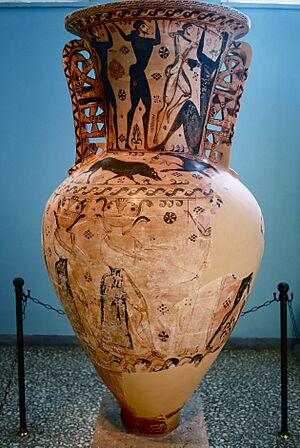Eleusis Amphora facts for kids
The Eleusis Amphora is a large, ancient Greek pot called a amphora. You can find it today in the Archaeological Museum of Eleusis. This special pot was made a long, long time ago, around 650–625 BCE. The artist who painted it is known as the Polyphemos Painter. The amphora is decorated with black and white pictures on a light background. This style was very popular during the "Black and White" period of Protoattic pottery. The pictures on the amphora show scenes from myths, often with people and animals, which was common for pottery from the Orientalizing period (around 710–600 BCE).
Contents
What Was the Eleusis Amphora Used For?
The Eleusis Amphora is very big and beautifully decorated. This suggests it was first made to be a special marker for a tomb or a monument. However, something interesting was found inside it: the remains of a boy who was about 10 to 12 years old. This means the amphora was actually used as an urn to hold the boy's ashes. Using pots as urns for children was a common way to bury them from the Iron Age (1100–900 BCE) up to the Archaic period (600–500 BCE) in ancient Greece.
What Pictures Are on the Eleusis Amphora?
The Eleusis Amphora shows some of the earliest pictures of famous Greek mythology stories.
Odysseus and the Cyclops
On the top part, or "neck," of the pot, you can see pictures of Odysseus and his men. They are shown blinding the giant one-eyed monster called Polyphemus. This is a famous scene from the ancient Greek epic poem, The Odyssey.
Animals and Monsters
Right below the neck, there is another picture. It shows a lion chasing a wild boar. It's a bit hard to see because the amphora was found in many pieces and then put back together. In the middle section of the pot, you can see Athena and Perseus. They are shown escaping after Perseus cuts off the head of Medusa. Medusa was a terrible monster with snakes for hair. Other figures with heads shaped like cauldrons are more gorgons, which are snake-headed creatures just like Medusa.


